 The literal meaning of the word chakra is ‘wheel or circle’, but in the yogic context, a better translation of the Sanskrit word is ‘vortex or whirlpool’. The Chakras are vortices of psychic energy, and they are visualized and experienced as circular movements of energy at particular rates of vibration.
The literal meaning of the word chakra is ‘wheel or circle’, but in the yogic context, a better translation of the Sanskrit word is ‘vortex or whirlpool’. The Chakras are vortices of psychic energy, and they are visualized and experienced as circular movements of energy at particular rates of vibration.
In each person, there are myriads of chakras, but in the practices of Yoga, only a few principal ones are utilized. These chakras span the full spectrum of man’s being from the gross to the subtle. The chakras are physiological as well as psychic centres whose structures correspond more or less with the traditional descriptions. These nerve centres are not situated inside the spinal cord itself but lie like junctions on the interior walls of the spinal column. If you cut the spinal cord transversely at different levels, you can see that the grey matter in the cross section resembles the lotus shape, and the ascending and descending tracts of nerve fibres correspond to the nadis. These communicating nerve fibres control the different physiological functions of that portion of the body.
A chakra is like a centrally placed electricity pole from which electrical wires are run to different places, houses and street lights in the vicinity. This arrangement is the same for each of the chakras. The nadis which emerge from each chakra carry prana in both directions. There is a forward and backward pranic motion in the nadis.
The outgoing communication and the incoming reaction enter and leave the chakra in the form of this pranic flow in the corresponding nadis. There are six chakras in the human body which are directly connected with the higher unilluminated centres of the brain. Bindu and Sahasrara are included in the diagram because they are important centres. However, they are not chakras in the real sense of the word. Bindu is said to be the original creation point of the universe.
From a scientific viewpoint you could say that the singularity that existed before the big bang of the universe is the Bindu; likewise, it is the source from where we originated. Sahasrara is beyond the realm of ordinary earthly consciousness and transcends the physical altogether; it is this state of being that some of the greatest masters like Jesus and Buddha were able to function from that state of being. This level of consciousness represents the completion and culmination of human evolution.
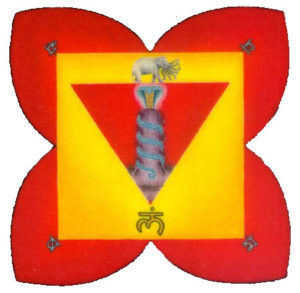 Mooladhara
Mooladhara
Mooladhara ChakraThe first chakra is mooladhara. It is situated on the pelvic floor and corresponds to the coccygeal plexus of nerves. In the male body, it lies between the urinary and excretory openings, in the form of a small dormant gland termed the perineal body. In the feminine body, it is situated inside the posterior surface of the cervix. Mooladhara is the first chakra in the spiritual evolution of man, where one goes beyond animal consciousness and starts to be a real human being. It is also the last chakra in the completion of animal evolution. It is said that from mooladhara chakra right down to the heels there are other lower chakras which are responsible for the development of the animal and human qualities of instinct and intellect. From mooladhara chakra upwards lie the chakras which are concerned with illumination and evolution of the higher man or superman. Mooladhara chakra has control over the entire range of excretory and sexual functions and has much to do with the security and survival issues of the body The Yantra for Mooladhara is a yellow square and has four dark red petals. The animal symbol is a grey elephant with seven trunks.
 Swadhisthana
Swadhisthana
Swadhistana ChakraThe second chakra is Swadhisthana, located at the lowest point or termination of the spinal cord. It corresponds to the sacral plexus of nerves and controls the unconscious mind. It also dominates one’s desire for worldly pleasures and sex. The Yantra for Swadhisthana is a silver-white crescent moon and has six orange-red petals. The animal symbol is a crocodile.
.
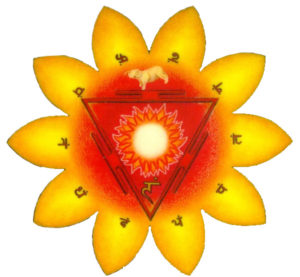
Manipuri
Manipuri ChakraThe third chakra is Manipuri, situated in the spinal column exactly at the level the navel and it controls the entire processes of digestion, assimilation and temperature regulation in the body. It corresponds to the solar plexus and controls body energy, digestion, and emotions. The Yantra for Manipuri is a Red inverted triangle and has ten yellow petals. The animal symbol is a ram.
.
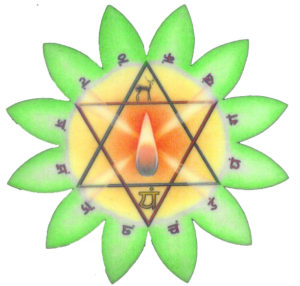 Anahata
Anahata
Anahata ChakraThe fourth chakra is Anahata, and it lies in the vertebral column behind the base of the heart, at the level of the depression in the sternum. It corresponds to the cardiac plexus of nerves and controls the functions of the heart, lungs, diaphragm and other organs in this region of the body. It is also responsible for the higher emotions of man such as love and compassion. The Yantra for Anahata is a smoky six-pointed star and has 12 Green / blue petals. The animal symbol is an antelope.
.
 Vishuddhi
Vishuddhi
Vishuddhi ChakraThe fifth chakra is Vishuddhi, which lies at the level of the throat pit in the vertebral column. This chakra corresponds to the cervical plexus of nerves and controls the thyroid. Vishuddhi is also responsible for self-expression and creativeness. The Yantra for Vishuddhi is a white circle star and has 16 Blue / purple petals. The animal symbol is a white elephant with seven trunks.
.

Ajna
Ajna ChakraAjna Chakra, the sixth and most important chakra, corresponds to the pineal gland, lying in the midline of the brain directly above the spinal column. This chakra controls the muscles and the onset of sexual activity in man. Agna chakra is the command centre and has complete control over all the functions of one’s life. These six chakras serve as switches for turning on different parts of the brain. The Yantra for Agna is a bright grey or purple circle and has two clear or grey or purple petals.
.
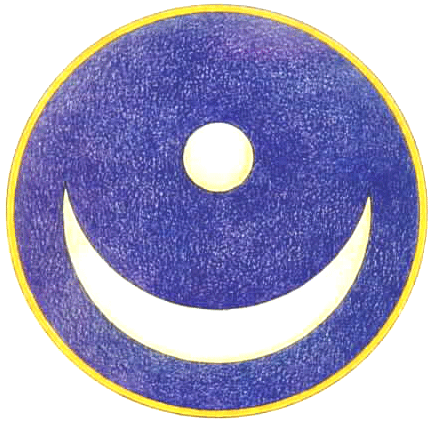 Bindu
Bindu
BinduBindu is not actually a chakra and is therefore not included in the traditional diagram above. However, it is worth mentioning as it is said to be the starting point for one’s whole being as well as for creation itself. Bindu is represented by a crescent moon and as the small sun which is said to be the centre of creation. It is located at the top back of the head, where Hindu Brahmins keep a tuft of hair. This is the point where oneness first divides itself into many. Bindu feeds the whole optic system and is also the seat of Nectar or amrita which drips down into Vishuddhi.
.
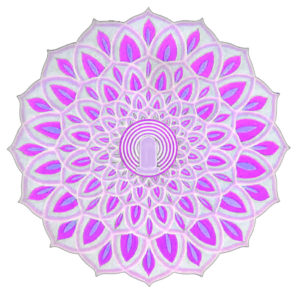 Sahasrara
Sahasrara
Sahasrara ChakraSahasrara is supreme; it is the final culmination of Yoga. It is the seat of higher awareness. Sahasrara is situated at the top of the head and is physically correlated to the pituitary gland, which controls each and every gland and system of the body.
There is no Yantra as such for Sahasrara because it is beyond the scope of Yantra. Sahasrara is said to have 1000 multi colour or red petals.
.
Summary
There is much symbology involved with chakras as you can see by the pictures. Each chakra is represented by a lotus flower with a certain number of petals, a particular colour, an element symbol, an animal symbol and many mantra symbols or sounds. There is much more symbolism that delves deeply into the stages of evolution of consciousness. However, that would require a significant amount of study to understand fully. This is just an overview of the general characteristics.
